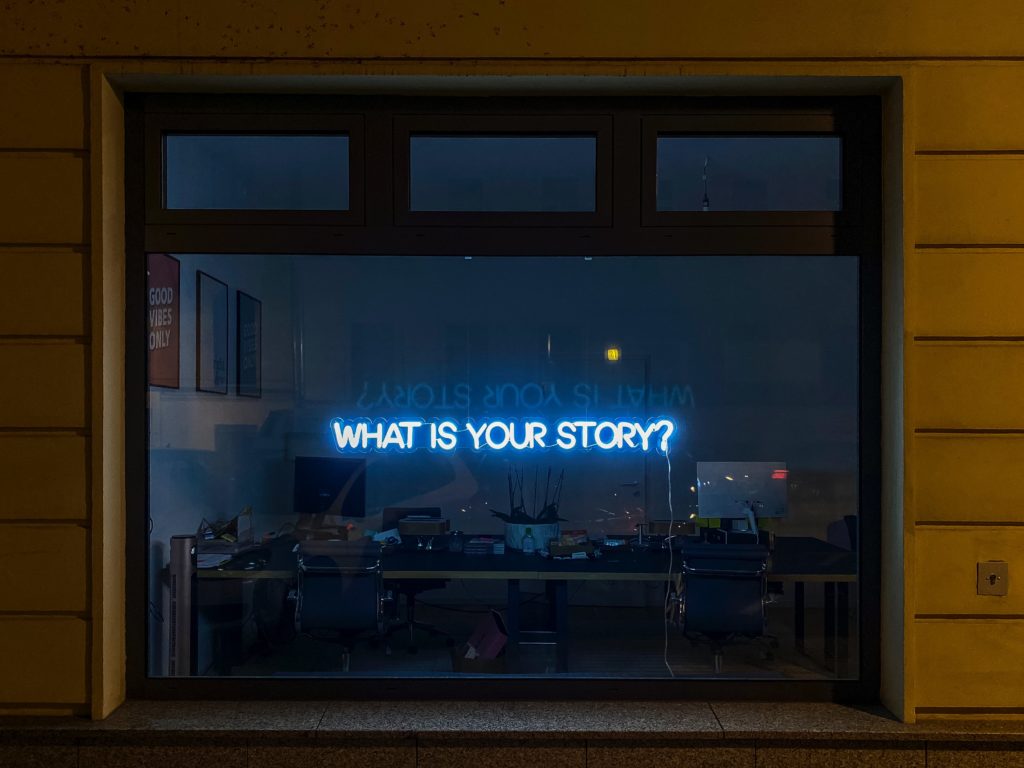Simon Sinek rocked the world of storytelling with his famous ‘start with why’ Ted Talk, “How Great Leaders Inspire Action”. Then, Nancy Duarte famously identified a structure that all great stories follow in her presentation, “The Secret Structure of Great Talks”. Steve Jobs inspired us to feel markedly inspired when he spoke, even by an inanimate object like a cell phone.
What is it about stories that people love so much? How do they inspire people to take action, make a change, or make a purchase? Why have they been passed down among civilizations since the dawn of time, shared over fireside chats, dinner conversations, rap songs, novels, and cinemas? In this article, we investigate why storytelling is so important, what makes a good story, and how creatives should think about storytelling when creating content.
Why does storytelling matter?
There are a few reasons why stories connect so deeply with audiences, transforming products into household names, CEOs into heralded leaders, would-be failures into celebrated triumphs.
Storytelling forges connection.
Every person has a story, although the bigger a business gets, or the more disconnected people feel from each other, the easier it can be to lose sight of that. Storytelling is the bond that reconnects. Storytelling makes brands become personable and people from other walks of life feel relatable. Stories convey the culture, history, and values unique to a community—or shared among all of us.
Storytelling makes a lasting impact.
Research shows that facts are 20 times more likely to be remembered if they’re part of a story. In a world filled with commercials ads, people are bombarded by information, facts, and figures. Stories transcend those indistinguishable bits of information into something that people can retain and relate to—day-to-day life, drama, relationships, passion, lessons, sacrifice, and celebrations.
Storytelling illustrates the path forward.
Whether a story is told by Dr. Martin Luther King, Jr., or a sales rep marketing skinny tea, stories paint a picture of what’s possible. They help people imagine something that they haven’t thought of before, or help them see what they want in a new light. Stories help people believe in possibility, help them recommit to their vision, and inspire them to take action.
What are the elements of a good story?
While people and brands may differ in which kind of stories they prefer, from light-hearted tales to action-packed adventures, nearly everyone knows a good story when they hear one. Below are a few key elements that make a good story.
Hook
First and foremost, a story must bring the audience in. It has to frame what’s possible and what’s at stake so a listener knows why they want to come along for the journey.
Empathy
Empathy is what transcends a story from existing as its own entity to connecting with people. Empathy values where people are coming from and tailors the story accordingly.
As a storyteller, you want your audience to come away from your story thinking about things differently, believing in your product, or adopting your vision. Empathy is what helps them get there. First, consider: where are they currently? What would help them see things differently? What mediums would keep their interest? What would make them trust you? People buy from people they like, know and trust—and they listen and learn from them, too.
Vision
From movies to novels to online courses, a great story is one that helps people believe in possibility. Great stories inspire. Consider what your audience wants more than anything. What dream have they given up on? What do they hope could be true, if you could show them the way?
Keep in mind, as the storyteller, you might not be the center of your story—your data, product, or service could be instead—but you are the guide, the sherpa, and the mentor showing your audience what’s possible, how to get there, and how to believe in a greater vision.
Repetition
In her acclaimed Ted Talk, Duarte shows that all memorable speeches follow the same structure—a repetition of what is at stake and what is possible. Your audience may be new to your topic, so use repetition to engrain what is at risk and what is possible.
To be clear, we aren’t suggesting that you literally repeat things over and over again. But rather, come at your perspective from various angles. Say it one way, then another. Say it aloud, then show it on screen. Illustrate your point through the experience of one person, then another. Tell quotes. Accentuate with data. Great stories ebb, flow, and repeat like the chorus of a song.
Tension, release
From the beginning of time, cultures have communicated their values, parents have taught children their lessons, and companies have demonstrated their expertise through tension.
Consider where the turning point was in your story. Were you up to your eyeballs in spreadsheets until—aha—you saw it? Were you about to give up on your dream until an unexpected breakthrough? What is at stake? What could be? What makes all of it worth fighting for? Take people through the highs and lows to keep their attention through tension and release.
How should creatives think about storytelling when creating content?
If you’re ready to create your next story for the ages—or at least for your current audience— the following questions will help guide you in creating a compelling story that connects.
What is the purpose of your story?
It can be helpful to remember why you’re telling the story at hand. Are you wanting to educate, to inform, or to entertain? If you’re telling a story to educate, you’re helping people understand how to do something. If you’re telling a story to inform, you’re keeping people up-to-date on important information. And if you’re telling a story to entertain, you’re sharing something that makes people laugh, smile, or feel amused. One isn’t better than the other, but it can be helpful when outlining your story to consider your main objective, and draft accordingly.
What format would convey your story best?
Over time, the format of storytelling has evolved. Whereas cavemen told stories over fires or on cave walls, technology has given way to new formats for storytelling, from print publications to radio to television to the internet. Currently, creatives have dozens of mediums at their disposal, from blog posts to audio recordings to video voiceovers. To determine which one is right for your story, weigh factors like length, audience, and complexity.
For example, highly complex content may be aided by video or images, whereas extremely long content may be too long for a blog post but perfect for a podcast episode or multi-part series. If you’re sharing information with millennials, video might be the ideal medium, whereas if your audience is less tech savvy, complex technical formats may be harder to navigate. If you’re showing something on screen, maybe a voiceover would help annunciate the content. Breaking content into bite-size pieces has been shown to aid learner recall, so play with length and cut what doesn’t add to your story.
What is the desired outcome of your story?
This is slightly different than the purpose of your story, in that with this question, you want to consider the action you want people to take after hearing your story. Is it to make a purchase, to understand a new process, to share with a friend, to trust your company, to feel inspired, or something else? Beginning with the end in mind—and gearing your story toward this—can help you get clear on a call-to-action and help you structure your story accordingly.
These days, we watch stories on videos, listen to stories on earbuds, and share stories over Zoom calls. In the future, we may swap stories in space flights, but the overarching truths of storytelling remain the same. Whether told by brands, neighbors, colleagues, or creatives, stories are what bond us, inspire us, change us, and move us. The bigger the story, the bigger the opportunity—for you, your business, and your audience alike.
Credits
Photo by Etienne Girardet on Unsplash




